Ebrahim Raisi: What we know about deadly Iran helicopter crash
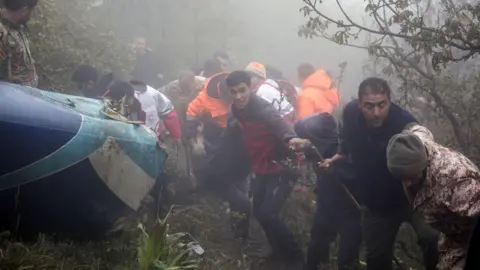 EPA
EPAPresident Ebrahim Raisi and seven other people were killed on Sunday when the helicopter they were travelling in came down near the border with Azerbaijan, Iranian authorities have confirmed.
This is what we know so far about the crash.
Why was the president flying in a helicopter?
Raisi flew to the far north-western province of East Azerbaijan on Sunday morning for the inauguration of the Qiz Qalasi and Khoda Afarin dams, a joint hydroelectric power project with neighbouring Azerbaijan on the Aras river.
He was joined at the ceremony by Azerbaijan’s President, Ilham Aliyev, who said he had bid a “friendly farewell” before the helicopter departed the dam area and flew towards the city of Tabriz, about 130km (80 miles) to the south.
Raisi had been scheduled to inaugurate a project at the Tabriz oil refinery.
Who else was on board the aircraft?
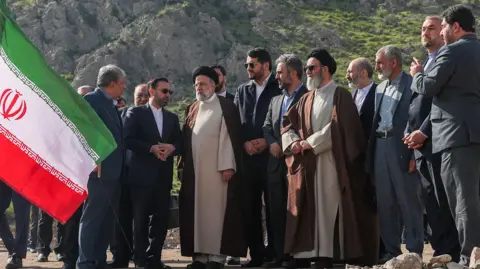 EPA
EPAThere were seven people accompanying the president who also died in the crash, according to the commander-in-chief of the Islamic Revolution Guard Corps (IRGC), Major General Hossein Salami.
They included Iran’s Foreign Minister, Hossein Amir-Abdollahian, as well as the governor of East Azerbaijan province, Malek Rahmati, and Tabriz’s Friday prayer leader, Ayatollah Mohammad Ali Al-e Hashem, a senior Shia cleric who was also Supreme Leader Ali Khamenei’s official representative in East Azerbaijan.
Gen Salami identified the others as IRGC Brig-Gen Mohammad Mehdi Mousavi, the head of the president's security team, pilots Col Mohsen Daryanush and Col Seyyed Taher Mostafavi, and technician Maj Behrouz Qadimi.
Where did the helicopter crash?
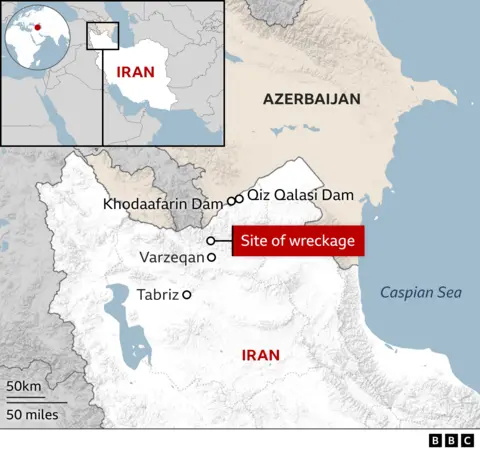
The incident occurred at around 13:30 local time (10:00 GMT) in a remote, mountainous area about 58km (36 miles) south of the Qiz-Qalasi Dam and 2km south-west of the village of Uzi, according to Iranian officials and photographs published by state media.
But it was not until after 16:00 local time (12:45 GMT) that Iranian state TV reported that the helicopter carrying the president had experienced what it called a “hard landing” while flying to Tabriz in heavy fog and rain.
Interior Minister Ahmad Vahidi later confirmed that the president’s delegation had been travelling in a convoy of three helicopters and that his aircraft was “forced to make a hard landing due to bad weather conditions and fog in the area”.
He said multiple rescue teams were heading to the area but that fog, snow and rain and the local terrain were hampering the search operation.
As for the other two helicopters that were flying alongside the president's helicopter, they had initiated a search for 15 to 20 minutes after communication was lost. They were then forced to make emergency landings, an official told state TV as the operation continued into the night.
Vice President for Executive Affairs Mohsen Mansouri also said contacts had been made with two people on the president’s helicopter - a flight crew member and one other individual.
"This indicates that the severity of the incident was not very high, as two of the individuals inside the helicopter managed to communicate with our team multiple times,” he added, without providing further details.
However, any hopes that Raisi and his entourage had survived were dashed after daybreak on Monday.
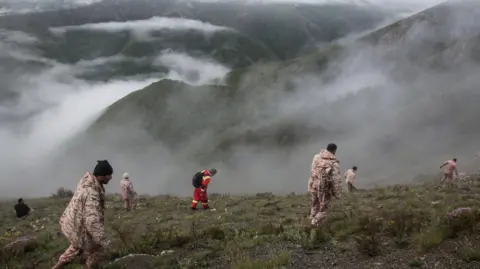 Reuters
ReutersWhat was found at the scene?
At about 05:00 (01:30 GMT), rescuers spotted the wreckage from a distance from about 2km (1.2 miles) and then took about an hour to reach it, according to the head of the Iranian Red Crescent, Pirhossein Kolivand.
Once at the crash site, which was at an altitude of around 2,200m (7,200ft), they found “no signs of life”, Mr Kolivand told state TV.
State TV also broadcast grainy footage of the crash site on a mountainside, as seen from across a valley. It appeared to show the blue-and-white tail of a helicopter next to a number of burnt shrubs.
Later, after the death of President Raisi and the others on board had been announced, state TV broadcast footage showing a correspondent standing in front of the tail and what appeared to be other parts of the wreckage.
State news agency Irna also posted video showing rescuers carrying a body wrapped in a blanket in a stretcher.
The bodies were recovered and transferred to a cemetery in Tabriz, state TV said.
The head of Iran’s crisis management agency, Mohammad Nami, told the semi-official Tasnim news agency that all of the bodies were identifiable, with “no need for DNA examinations”.
He also said Ayatollah Al-e Hashem was alive for an hour after the crash and that he made contact with the head of the president’s office before he died.
What was the cause of the crash?
Iranian authorities have so far not given a cause.
However, government ministers have described how the helicopter crashed after getting into difficulties in heavy fog and rain.
What do we know about the helicopter?
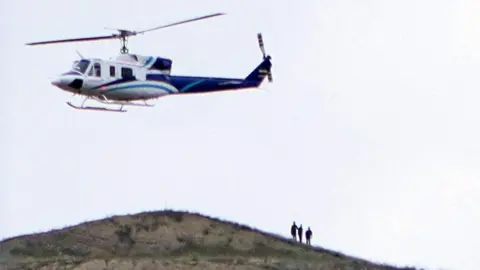 Reuters
ReutersState media identified it as Bell 212, a model which was developed by a US company for the Canadian military in the 1960s.
Iran’s navy and air force have a total of 10, according to FlightGlobal's 2024 World Air Forces directory, but it is unclear how many the Iranian government operates.
State-run IRNA news agency says the helicopter carrying the president could carry six passengers and two crew.
According to the Flight Safety Foundation, the last fatal incident in Iran involving a Bell 212 before Sunday happened during a medical evacuation in April 2018.
What has been the reaction in Iran?
Iran’s Supreme Leader Ayatollah Ali Khamenei - who has ultimate authority in the Islamic Republic - expressed his condolences over what he called the “bitter tragedy” and declared five days of public mourning.
“With deep sorrow and regret, I have received the bitter news of the martyrdom of the people’s president, the competent, hard-working Hajj Sayyed Ebrahim Raisi, and his esteemed entourage,” he said.
A statement issued by Iran’s cabinet said the president had “made the ultimate sacrifice on the path of serving his nation”.
Ministers also promised Iranians that they would follow Raisi’s path and there would “be no problem with management of the country”.
Raisi's moderate rival and predecessor, Hassan Rouhani, expressed his condolences and said "a bitter page has turned in the Islamic Revolution's book".
Former foreign minister Mohammad Javad Zarif told state TV that the US was indirectly to blame for the crash because it had maintained years of sanctions that prevented Iran from buying new aircraft.
Who has succeeded Raisi as president?
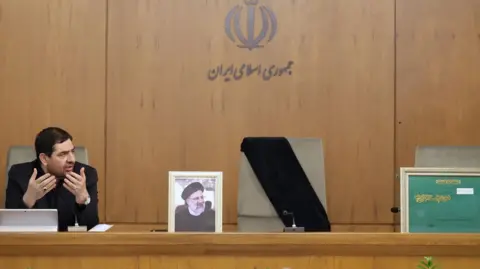 Reuters
ReutersAyatollah Khamenei confirmed that Vice-President Mohammad Mokhber had been appointed acting president, in line with Article 131 of Iran’s constitution.
The constitution states that the acting president will then jointly with the heads of parliament and the judiciary oversee an election for a new president within a maximum of 50 days.
Iran’s veteran nuclear negotiator and deputy foreign minister, Ali Baqeri Kani, was also named as the acting foreign minister, a government spokesman said.
He can serve in the post for a maximum of three months before a permanent replacement must be nominated and approved by parliament.
